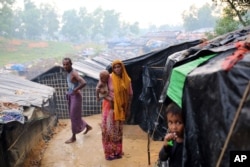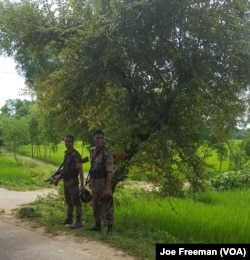Abdul Aziz arrived in the Kutupalong refugee camp in southern Bangladesh one month ago, shortly after deadly violence erupted between the Arakan Rohingya Salvation Army and Myanmar’s military Aug. 25.
The 48-year-old is one of more than 500,000 Rohingya Muslims to flee Myanmar since the clashes, which were sparked by Rohingya insurgent attacks on police and army posts.
He left all his property and belongings behind, arriving in Bangladesh with only the clothes on his back. But when he got to the crowded camp he noticed a new problem.
“There’s no space to pray,” he explained, standing beside several upright planks of wood that hold a tarpaulin sheet over a small expanse of dirt.
Aziz, who is from Maungdaw in Myanmar’s northern Rakhine State, indicated the shelter would serve as a mosque, and that he had collected donations to help build it.
As he spoke, a man stepped out into the crowded pathway and recited the call to prayer, which competed with the din of daily activity in the bustling camp.
Mosques to require authorization
Makeshift mosques are cropping up across the emerging settlements, as Rohingya Muslims look to replace houses of worship left behind.
But Aziz’s project, and others like it, may not last long.
The Dhaka Tribune reported that Bangladesh officials this week said all newly established mosques and madrassas, or Islamic schools, would be demolished, and that new ones would require authorization from the army.
Observers and analysts say the despair and destitution in the camps could provide the ideal breeding ground for extremist recruitment, but a senior government official said the recent decision was more practical.
“Actually, we build mosques in a structured way when we are building the new camp. But at present if anyone establishes mosques temporarily, we have to pull it out,” said Mohamed Reza, an assistant secretary with Bangladesh’s Ministry of Disaster and Relief. “So we discourage them. If at the [current] time you build a mosque, it will be destroyed when [we commence] regular construction process.”
“Some of the people actually they are religious minded ... so they think that it is the time to be building mosques. But we say that you are building mosques but unplanned,” he added.
Bangladesh announced Thursday that the Kutupalong refugee camp, one of two pre-existing camps for Rohingya, would be formally extended to accommodate new arrivals.
“All of those who are living in scattered places ... would be brought into one place,” the Minister for Disaster and Relief, Mofazzal Hossain Chowdhury Maya, told AFP.
800,000 refugees
Taking into account waves of Rohingya refugees fleeing previous bouts of violence over the decades, there are now more than 800,000 in southern Bangladesh, and humanitarian agencies are struggling to respond.
Myanmar and Bangladesh held talks on the crisis earlier this week. The civilian government led by Aung San Suu Kyi said it would take back those who fled this past year under a verification process established in the 1990s, but many will lack the proper documentation.
The unprecedented scale of the influx and the allegations of atrocities against Rohingya civilians have led to accusations of ethnic cleansing, which Myanmar forcefully rejected at the United Nations General Assembly last month.
Though the initial influx has slowed, arrivals keep coming each day, and space dwindles. Refugees are occupying 9.6 million square acres according to the United Nations.
Army called in
The Bangladesh government has called on the army to help establish control, and units have deployed in the camps and at checkpoints along the road leading from the placid beachfronts of Cox’s Bazar.
Members of Bangladesh’s feared Rapid Action Battalion were also seen up and down the road from Kutupalong camp to farther south in Tekhnaf.
“At present the army is assisting the civilian administration,” Reza said, adding he was not concerned about “security problems.”
Aziz said he would return home if basic rights were granted. One of the benefits of being in Bangladesh was that he felt freer to practice his religion.
“We’re restricted in Myanmar,” he said.










